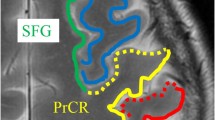Abstract
Purpose
Internuclear ophthalmoplegia is caused by a lesion; stroke, multiple sclerosis, brain metastases, or trauma may produce lesions of the medial longitudinal fasciculus (MLF). Imaging techniques, such as DWI, can help identify the site of the lesion in order to speed diagnosis and lead to appropriate treatment.
Methods
Over an 8-month period, eight consecutive patients with suspected MLF syndrome (most secondary to ischemic stroke) underwent MRI examinations, including DWI sequencing, at an academic center in Taiwan.
Results
In all eight patients, abnormal high-signal lesions were found close to the floor of the fourth ventricle on the dorsal side of the pons. A neuroanatomical comparison showed that the location of the lesions was identical to the anatomical position of the MLF.
Conclusion
Using DWI, good clinico-radiological correlation was found in all eight ischemic stroke patients diagnosed with MLF syndrome. DWI may broaden the application of MRI in the diagnosis of MLF syndrome.




Similar content being viewed by others
References
Basser PJ, Mattiello J, LeBihan D (1994) MR diffusion tensor spectroscopy and imaging. Biophys J 66:259–267
Budde MD, Kim JH, Liang HF, Schmidt RE, Russell JH, Cross AH, Song SK (2007) Toward accurate diagnosis of white matter pathology using diffusion tensor imaging. Magn Reson Med 57:688–695
Fox RJ, McColl RW, Lee J-C, Frohman T, Sakaie K, Frohman E (2008) A preliminary validation study of diffusion tensor imaging as a measure of functional brain injury. Arch Neurol 65:1179–1184. doi:10.1001/archneur.65.9.1179
Frohman EM, Zhang H, Kramer PD, Fleckenstein J, Hawker K, Racke MK, Frohman TC (2001) MRI characteristics of the MLF in MS patients with chronic internuclear ophthalmoparesis. Neurology 57:762–768
Frohman TC, Galetta S, Fox R, Solomon D, Straumann D, Filippi M, Zee D, Frohman EM (2008) Pearls & Oysters: The medial longitudinal fasciculus in ocular motor physiology. Neurology 70:e57–e67. doi:10.1212/01.wnl.0000310640.37810.b3
Gupta RK, Saksena S, Agarwal A, Hasan KM, Husain M, Gupta V, Narayana PA (2005) Diffusion tensor imaging in late posttraumatic epilepsy. Epilepsia 46:1465–1471
Karatas M (2009) Internuclear and supranuclear disorders of eye movements: clinical features and causes. Eur J Neurol 16:1265–1277. doi:10.1111/j.1468-1331.2009.02779.x
Kim JS (2004) Internuclear ophthalmoplegia as an isolated or predominant symptom of brainstem infarction. Neurology 62:1491–1496
Kim JS, Jeong SH, Oh YM, Yang YS, Kim SY (2008) Teaching NeuroImage: wall-eyed bilateral internuclear ophthalmoplegia (WEBINO) from midbrain infarction. Neurology 70:e35. doi:10.1212/01.wnl.0000299904.48116.cf
Leigh RJ, Zee DS (1999) The neurology of eye movements. Oxford University Press, New York
Miley JT, Rodriguez GJ, Hernandez EM, Bundlie SR (2008) Teaching NeuroImage: traumatic internuclear ophthalmoplegia. Neurology 70:e3–e4. doi:10.1212/01.wnl.0000280462.85951.3c
Niogi SN, Mukherjee P, Ghajar J, Johnson C, Kolster RA, Sarkar R, Lee H, Meeker M, Zimmerman RD, Manley GT, McCandliss BD (2008) Extent of microstructural white matter injury in postconcussive syndrome correlates with impaired cognitive reaction time: a 3T diffusion tensor imaging study of mild traumatic brain injury. AJNR Am J Neuroradiol 29:967–973. doi:10.3174/ajnr.A0970
Ogasawara K, Sasaki M, Tomitsuka N, Kubo Y, Inoue T, Ogawa A (2005) Early revascularization in a patient with perfusion computed tomography/diffusion-weighted magnetic resonance imaging mismatch secondary to acute vertebral artery occlusion. Case report. Neurol Med Chir (Tokyo) 45:306–310
Sakaie K, Takahashi M, Dimitrov I, Togao O, Davis S, Remington G, Conger A, Conger D, Frohman T, Fox R, Frohman E (2011) Diffusion tensor imaging the medial longitudinal fasciculus in INO: opportunities and challenges. Ann NY Acad Sci 1233:307–312
Sakamoto Y, Kimura K, Iguchi Y, Shibazaki K, Miki A (2012) A small pontine infarct on DWI as a lesion responsible for wall-eyed bilateral internuclear ophthalmoplegia syndrome. Neurol Sci 33:121–123. doi:10.1007/s10072-011-0647-8
Sidaros A, Engberg AW, Sidaros K, Liptrot MG, Herning M, Petersen P, Paulson OB, Jernigan TL, Rostrup E (2008) Diffusion tensor imaging during recovery from severe traumatic brain injury and relation to clinical outcome: a longitudinal study. Brain 131(Pt 2):559–572
Zwergal A, Cnyrim C, Arbusow V, Glaser M, Fesl G, Brandt T, Strupp M (2008) Unilateral INO is associated with ocular tilt reaction in pontomesencephalic lesions: INO plus. Neurology 71:590–593. doi:10.1212/01.wnl.0000323814.72216.48
Acknowledgments
This study was supported by a grant from National Cheng Kung University Hospital (NCKUH-9902052).
Conflict of interest
The authors declare that they have no conflict of interest.
Author information
Authors and Affiliations
Corresponding author
Rights and permissions
About this article
Cite this article
Chuang, MT., Lin, CC., Sung, PS. et al. Diffusion-weighted imaging as an aid in the diagnosis of the etiology of medial longitudinal fasciculus syndrome. Surg Radiol Anat 36, 675–680 (2014). https://doi.org/10.1007/s00276-014-1256-z
Received:
Accepted:
Published:
Issue Date:
DOI: https://doi.org/10.1007/s00276-014-1256-z




